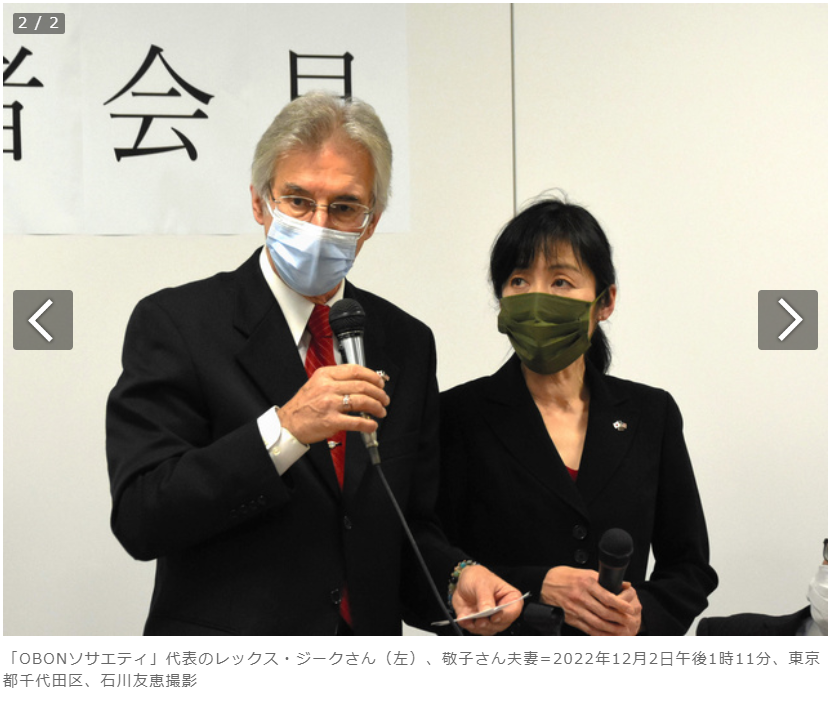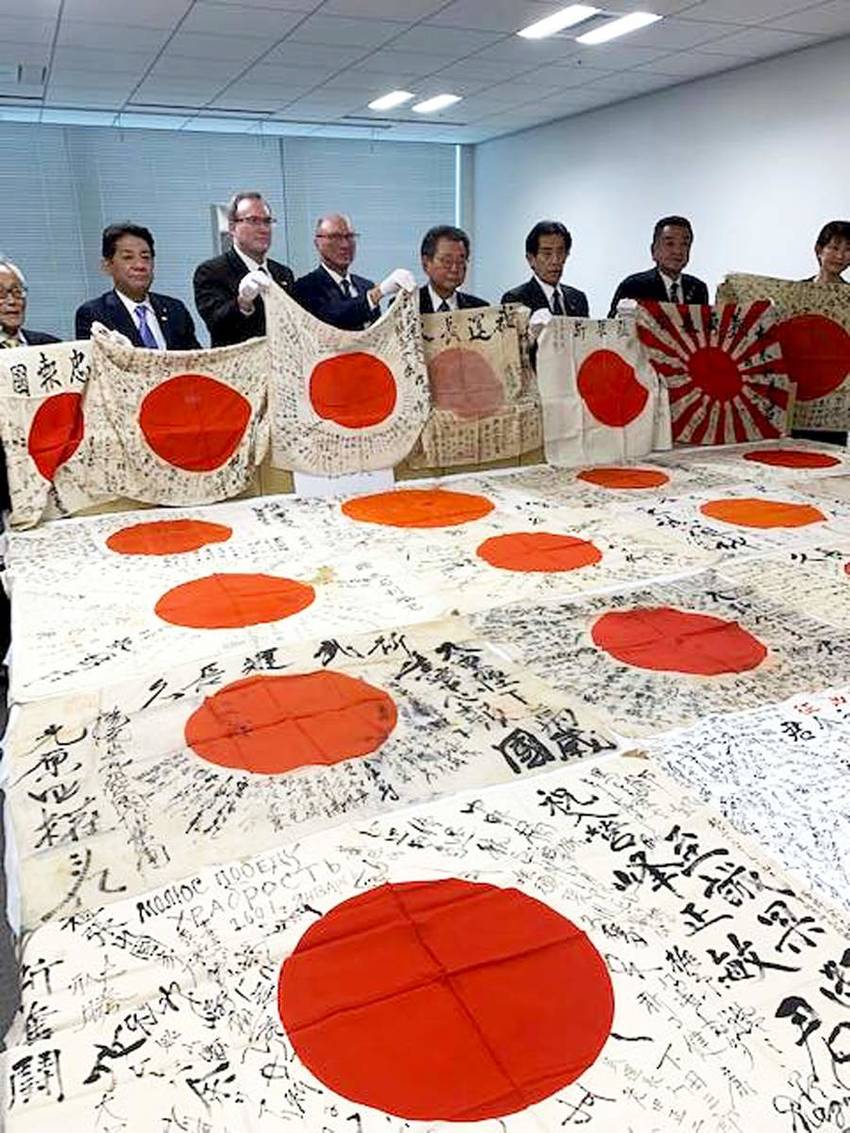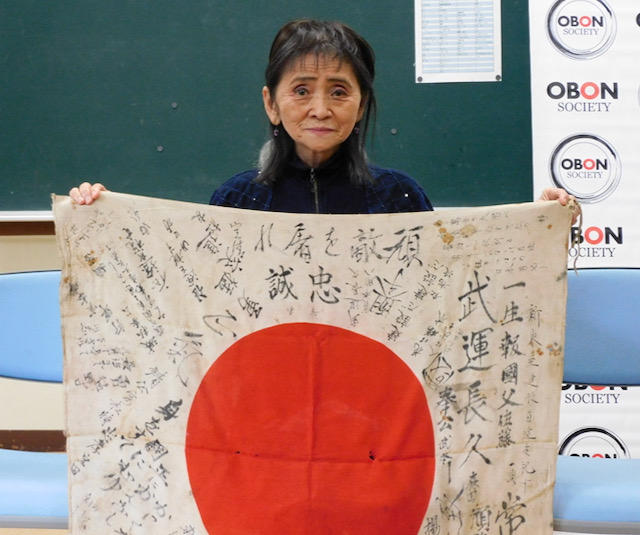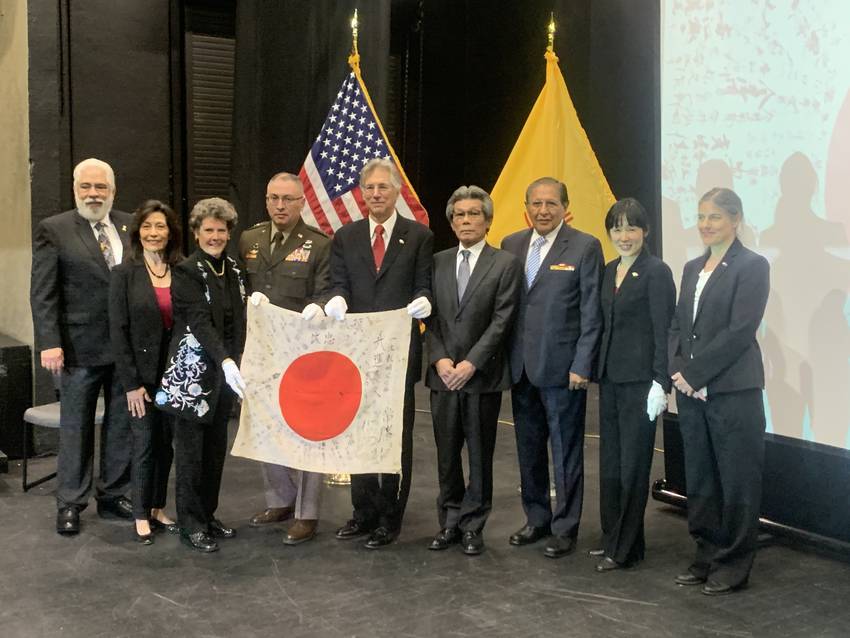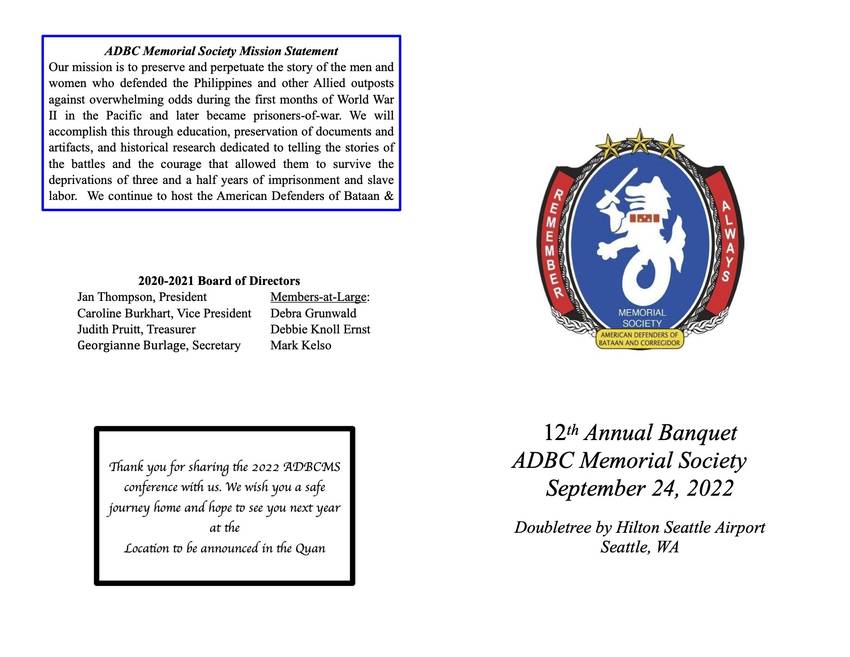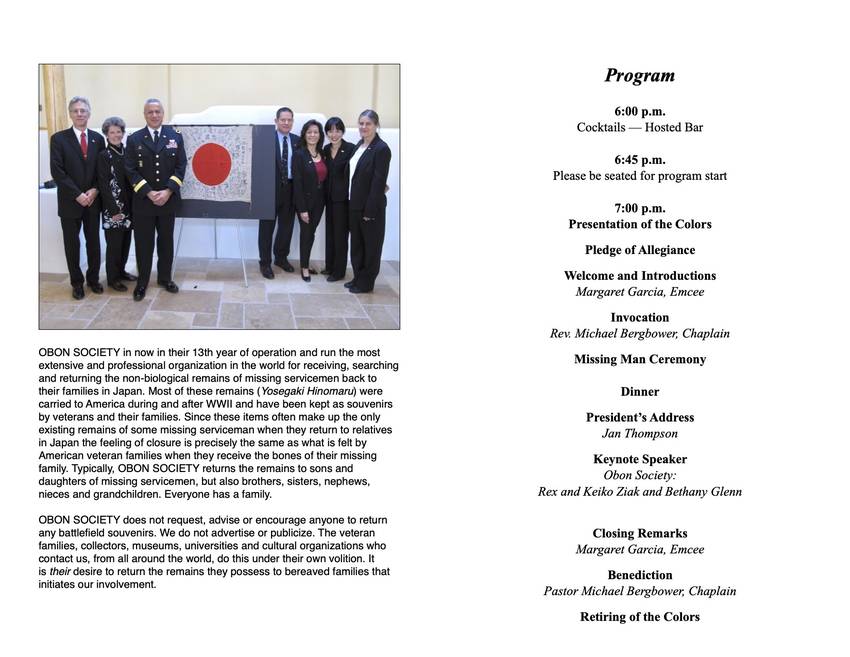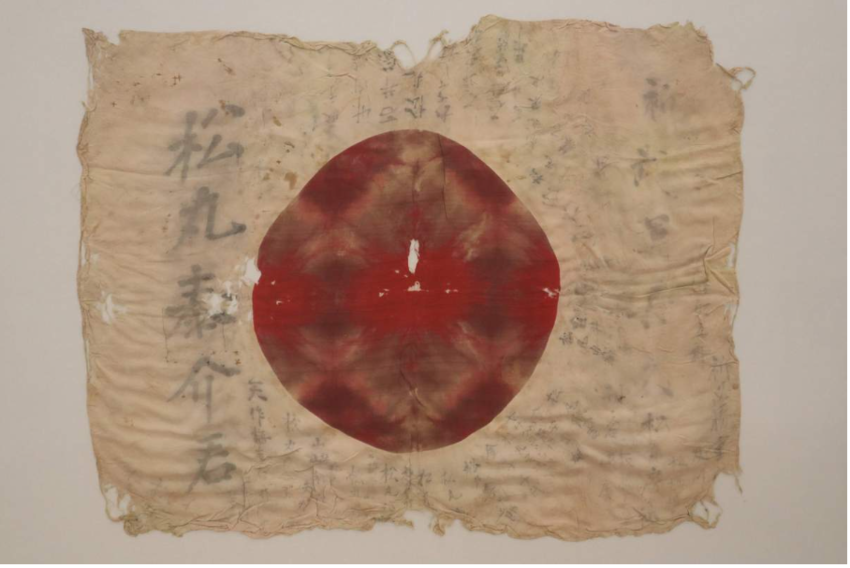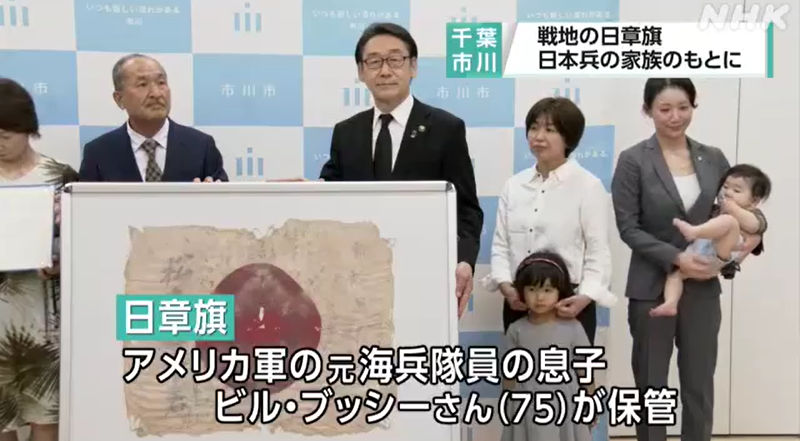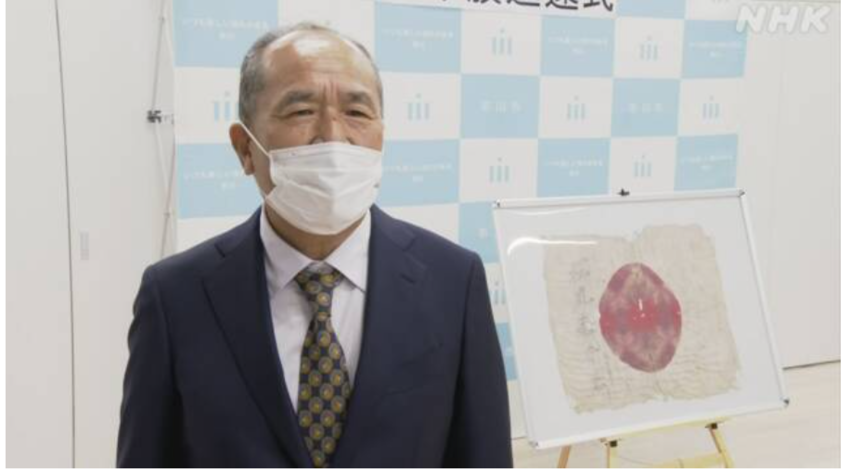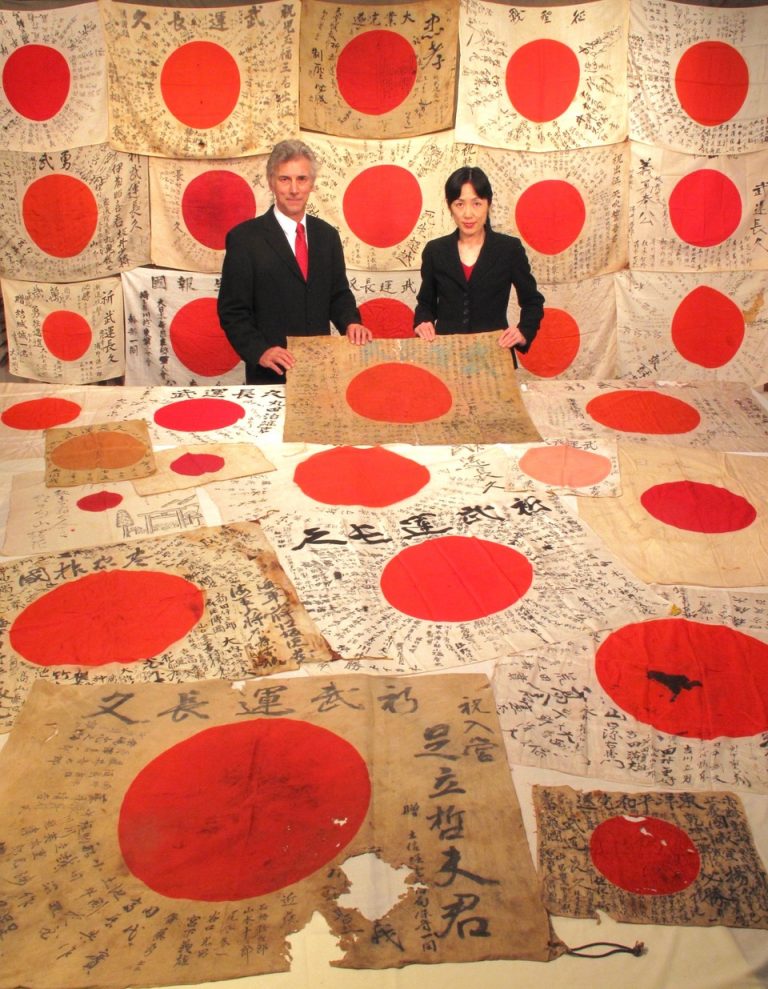出征した旧日本兵が戦地に持参し、寄せ書きがされた日章旗を遺族に返還する活動に取り組む団体がある。米オレゴン州の非営利団体「OBON(オボン)ソサエティ」。その代表レックス・ジークさんと妻の敬子さんが来日し、2日に記者会見を開いた。夫妻は「できるだけ早く、1枚でも多く返還していきたい」と語った。
団体が創設されたのは2009年。ビルマ(現ミャンマー)で戦没した敬子さんの祖父の日章旗がカナダに住む人から返還されたのがきっかけだった。
夫妻によると、米国に持ち帰られた旧日本兵の遺品は、旧米兵の家族がそのまま保管していたり、オークションに出されたりしているという。
誰も見向もしなかった活動 貯蓄切り崩し……
日章旗には持ち主の名前のほか、寄せ書きをした多くの人の名前も記されている。こうした手がかりから遺族を探し出しているという。レックスさんは「遺骨も遺品も戻らない遺族がいる。そうした遺族に発見された日章旗を届けたかった」と話す。
当初は夫妻自らの貯蓄をもとに活動していたが、19年度以降は国の遺留品調査事業を担う日本遺族会からの委託をうけ、日章旗などの返還に取り組む。敬子さんは「最初は誰も見向きもしなかったが、一枚一枚返していくことでようやく活動が広がった」と言う。
これまで遺族のもとに返還できた日章旗は427枚(22年10月末現在)。ただ、遺族らが不明で未返還のものが約2400枚あるという。
戦後77年が過ぎ、遺族の高齢化も進む。「できる限り早く返したい」と話すレックスさんはこうも訴える。「(戦没者を知る)世代で終わるわけではない。孫やひ孫の代になっても続け、次の世代に伝えていくことが大切だ」
4日には、日章旗を所持していた米国人とともに、広島県の遺族に対面して返還する予定だ。(朝日新聞・石川友恵)
![米NPO法人「OBONソサエテ...]() 米NPO法人「OBONソサエティ」が所持していた日章旗=2日、東京都千代田区
米NPO法人「OBONソサエティ」が所持していた日章旗=2日、東京都千代田区
米NPO、旧日本兵の日章旗240枚を遺族会に返還
2022/12/2
米NPO法人「OBONソサエティ」が所持していた日章旗=2日、東京都千代田区
先の大戦で元米兵らが戦場から持ち帰った日本兵の遺留品を遺族に返還する取り組みを行っている米NPO法人「OBONソサエティ」(本部・オレゴン州)は2日、東京都内で日本遺族会とともに記者会見し、同法人が所持する240枚の日章旗を公開した。今後、遺族会が所有者を調査し、遺族への返還を目指す。
記事の続きは下記リンク先をご覧ください。
https://www.sankei.com/article/20221202-IR7CSCNEFVLCDLXHH7PAXUH2LM/?
![This Yosegaki Hinomaru had b...]() This Yosegaki Hinomaru had been kept in the New Mexico National Guard Museum in Santa Fe for years.
This Yosegaki Hinomaru had been kept in the New Mexico National Guard Museum in Santa Fe for years.
Happy Holidays from OBON SOCIETY. Please click the link below for our latest news.
https://mailchi.mp/1dadd51a45f9/happy-holidays-from-obon-society
![ニューメキシコ軍事博物館にて:...]() ニューメキシコ軍事博物館にて:
ニューメキシコ軍事博物館にて:
日章旗返還依頼をされた米国関係者らとOBONソサエティ・スタッフ
10月11日(火)午前11時から、佐藤守男命「寄せ書き日の丸」返還式が出身地である佐賀県脊振町にて行われました。
ご英霊が長い年月を経て、ようやく日章旗と共にご遺族のお手元へ戻れることとなり、本当に感慨深い思いでおります。
この佐藤守男命「寄せ書き日の丸」は、アメリカで初めて軍隊が返還を決意された非常に特別な旗です。関係者と共に訪日をして旗を手渡せるように希望していたのですが、コロナ禍などの事情によりこの度の訪日は叶いませんでしたが、ニューメキシコ州兵軍と全米バターン・コレヒドール防衛兵の会ら関係者と共に動画メッセージを作成しました。日本の皆様にもお届けしたいメッセージです。是非、ご視聴ください!
https://youtu.be/taSLGqV8v0c
太平洋戦争で南方・ガダルカナル島に出征し、1943年(昭和18)1月6日、32歳で戦死した旧白崎村(現由良町)大引出身で陸軍伍長だった中谷正廣さんの「千人針」が見つかり、26日、町役場でめいの福田優子さん(79)=大引=に引き渡された。元米兵の家族が保管し、80年近くの時を経て日本、そして遺族の元に戻った遺品。
関係者は英霊の冥福を祈るとともにあらためて恒久平和を願った。
千人針は1000人の女性が一針ずつ縫って結び目をこしらえた白木綿の布。これを肌につけて戦争に赴けば戦苦を免れて無事に帰還できるという風習があり、太平洋戦争まで日本で盛んに行われていた。
中谷さんは5男5女合わせて10人きょうだいの4番目で三男。「大引 中谷正廣」と書かれた千人針は腹に巻いていたとみられている。元米兵が戦地から持ち帰り、アメリカ・ミネソタ州に住む子どもが保管。アメリカで寄せ書き日の丸(日章旗)をはじめ遺品返還活動に取り組んでいる団体「OBONソサエティ」を通じて返還の希望があり、日本遺族会、県遺族連合会、日高郡遺族連合会に連絡があって遺族を探していた。
引き渡しは県、日高郡両遺族連合会の杉本正博会長から福田さんに行われた。中谷さんのおいの東一美さん(88)=大引=らも同席し、山名実町長、日高郡遺族連合会や由良町遺族会の役員らが立ち会った。
千人針を保管していた家族からの「心からお詫びを申し上げますとともに、ご家族に安らぎが訪れますようお祈り申し上げます」というメッセージや写真も紹介され、杉本会長は「戦争は二度としてもらいたくない。体は戻らずとも遺品を見て昔をしのんでもらえれば」。福田さんは千人針に「実物を見るのは初めて。ここに名前がありますね」と感慨深そうに手を伸ばし、「正廣さんのことは家に出征時の写真が1枚あるだけ。よくとっておいてくださった。お手紙で感謝を伝えたい」と話していた。
※千人針(Sennin-Bari) 1000-stitch belt; soldier's charm with stitches by a thousand women.
https://hidakashimpo.co.jp/?p=83602
![返還された日章旗。左側に持ち主...]() 返還された日章旗。左側に持ち主である松丸泰介さんの名前が大きく記されている=16日、千葉県市川市(前島沙紀撮影)
返還された日章旗。左側に持ち主である松丸泰介さんの名前が大きく記されている=16日、千葉県市川市(前島沙紀撮影)
旧日本兵の日章旗、千葉・市川市が遺族に返還 米で発見される
2022/8/16 20:07
千葉県市川市は16日、同市から先の大戦に出征し、令和2年12月に老衰で亡くなった松丸泰介さんの日章旗を長男の裕一さん(71)に返還した。返還式には裕一さんやその家族、田中甲市長らが参加。日章旗は17日と23~31日、同市役所第1庁舎1階で行われる戦没者追悼行事と平和展で展示される。
泰介さんの日章旗は、国による戦没者の遺留品調査で米マサチューセッツ州で見つかり、今年1月に日本に届いたという。同州のビル・ブシーさんが1993年に父の遺品の中から発見し、保管していた。ブシーさんからは、「泰介様が第二次世界大戦から生還され、その後も長生きされたと知り、ほっとし喜んでいる。この先二度と同じことが繰り返されないよう願う」とメッセージが送られた。
裕一さんは日章旗が見つかったことについて、「ただただ驚いた。父が日章旗を携えていたと知らなかった」と話した。泰介さんはガダルカナル島やペリリュー島で米軍と戦ったという。裕一さんは、「99歳になる1週間前に亡くなった父は、戦争以外は本当に幸せな人生だったと思う。優しく運の強い人だった」と感慨深げに話した。
田中市長は、「幸せな国をつくるんだという思いが日章旗に込められていると思う」と指摘した。
裕一さんは「日章旗は大戦の遺物だと思うので、一家庭にとどめておくよりも皆さまの目にとまるところに置いてもらいたい」と、市に日章旗を寄贈する意向で、市歴史博物館で保存される予定だ。
https://www.sankei.com/article/20220816-YT2KJKWCVFKBPKMZ55GBMLD474/photo/GOUBK6FYB5LDNBRC6NJHX2FE24/
![泰介さんの息子の裕一さん(71...]() 泰介さんの息子の裕一さん(71)右
泰介さんの息子の裕一さん(71)右
![【NHK動画】太平洋戦争で日本...]()
太平洋戦争で日本兵が持って行った日章旗 家族のもとに返還
2022年8月16日 16時21分
太平洋戦争で日本兵が戦地に持って行った日章旗がその後、アメリカで発見され、終戦から77年を経て、16日、千葉県市川市の家族のもとに返還されました。
返還されたのは、市川市出身で、船舶工兵としてニューギニアなどで戦い、おととし、98歳で亡くなった松丸泰介さんの日章旗です。
この旗は、29年前に亡くなったアメリカ軍の元海兵隊員、オリバー・ブッシーさんの息子でマサチューセッツ州に住むビル・ブッシーさん(75)が保管していたもので、遺留品の返還に取り組むアメリカのNPO「OBONソサエティ」(オボン)を通して市川市役所に届けられていました。
16日は泰介さんの息子の裕一さん(71)らが田中甲市長から旗を受け取りました。
旗は縦66センチ、横83センチで、破れたり色がにじんだりしていますが、勝利を祈ることばや泰介さんの妻など家族や地域の人とみられる名前が寄せ書きされています。
返還式では、「この旗を家族のもとへ戻せることを大変うれしく思います」というビルさんからのメッセージも紹介されました。
裕一さんは「父の苦労のあとが伺える旗で、アメリカから戻ってきて本当によかったです。より多くの人の目に触れ平和の大切さを考える機会にしてもらうため市に寄贈したい」と話していました。
“戦うよりも生きるために食糧を探す日常だった”
松丸泰介さんの息子の裕一さんによりますと、泰介さんは大正10年生まれで、宮城県の石巻市から南太平洋のニューギニアなどに向けて出征し、船舶工兵として戦ったと聞いているということです。
泰介さんはおととし98歳で亡くなり、裕一さんは「前向きで地域のためにいろいろやる人でした。戦争については、戦うというよりも生きるために食糧を探すのが日常だったと聞いたことがある。あとは、足をやられたら置いていかれるからダメだと話していた」と振り返っていました。
16日に返還された旗は、破れや色あせ、インクのにじみがあり、かなり傷んだ状態ですが、「松丸泰介君」と大きく書かれた周りには、泰介さんの妻、百合子さんなど50人以上の名前があります。
返還式のあと、裕一さんは「戦争についてほとんど語らなかった父ですが、この旗を見てどんなに悲惨な戦争だったんだろう、語ることができなかったのではないかと思いました。日の丸の赤の中に血がにじむ思いがあると分かってくれて、大事にしまってくれたのだろう。ありがたい気持ちでいっぱいです」と話していました。
ビルさん “松丸さんも父も戦争を生き抜いた”
今回、返還された旗は、太平洋戦争中、アメリカ軍の海兵隊員としてガダルカナル島やパラオに赴いたオリバー・ブッシーさんが長く保管していたものでした。
オリバーさんの息子、ビルさんによりますと、オリバーさんが1993年8月に亡くなったあと10年以上たって家を売ることになった際、クローゼットから軍服や勲章などの記念品とともに箱の中に入っているのを見つけたということです。
今回、オンラインで取材に応じたビルさんは、旗を見つけたときのことを「ワックス紙で包まれていて、ガーゼのように薄く、すぐに壊れそうでした。何度も広げたら壊れてしまうと思い、一度だけ開きました」と振り返り、「父がこの旗を持っていたことすら私は知らなかったんです。太平洋戦争については決して多くを語らない人でした。ただ、少なくとも捨てなかったということは、敬意を持っていたのではないでしょうか」と話していました。
ビルさんは、友人に相談したり自分で調べたりする中で、日章旗など遺留品の返還に取り組むNPO「OBONソサエティ」のことを知り、団体を通じて旗を返還することになりました。
ビルさんは「松丸さんも父も戦争を生き抜き、それぞれ家庭を築くことができました。本当によかったです」と話していました。
https://www3.nhk.or.jp/news/html/20220816/k10013773061000.html?fbclid=IwAR2T2oQPg6G032oJFdJRSJ9HvaCslQgBjZhoDcZdO9dQmt3FzDUQs2ll0pw
![Taisuke's son Yuichi (71)]() Taisuke's son Yuichi (71)
Taisuke's son Yuichi (71)
Japanese flag taken by Japanese soldiers during the Pacific War returned to family
2022/8/16 12:45:51
[NHK] The Japanese flag that Japanese soldiers brought to the battlefield during the Pacific War was later discovered in the United States, and on the 16th, 77 years after the end of the war, a house in Ichikawa City, Chiba Prefecture...
The Japanese flag that Japanese soldiers took to the battlefield during the Pacific War was later discovered in the United States, and was returned to his family in Ichikawa City, Chiba Prefecture on the 16th, 77 years after the end of the war.
The flag that was returned was that of Taisuke Matsumaru, who was born in Ichikawa City and died at the age of 98 after fighting in New Guinea as a ship engineer.
This flag was kept by Bill Bussey (75), who lives in Massachusetts and is the son of Oliver Bussey, a former U.S. Marine who died 29 years ago. It was delivered to Ichikawa City Hall through the NPO "OBON Society" (Obon).
On the 16th, Taisuke's son Yuichi (71) and others received the flag from Mayor Kou Tanaka.
The flag is 66 centimeters high and 83 centimeters wide, and although it is torn and the colors are blurred, it contains words of prayer for victory and the names of family members and local people, such as Taisuke's wife.
At the handover ceremony, a message from Mr. Bill was also introduced, saying, "I am very happy to be able to return this flag to my family."
Yuichi said, "I'm really glad that I came back from America with the flag that shows the traces of my father's hardships. I want to donate it to the city so that more people can see it and have an opportunity to think about the importance of peace." was
https://www.tellerreport.com/life/2022-08-16-japanese-flag-taken-by-japanese-soldiers-during-the-pacific-war-returned-to-family.Hkeug75dAq.html?fbclid=IwAR3OCdsNpX8OSKbaTFsRG0HTtmlaG0dI5jo5cnZ4spEriOEuj4GeDRHcbOE
![「今も返還を待つ日章旗が多数あ...]() 「今も返還を待つ日章旗が多数ある」と活動を進める夫妻(米オレゴン州で)=OBONソサエティ提供
「今も返還を待つ日章旗が多数ある」と活動を進める夫妻(米オレゴン州で)=OBONソサエティ提供
日章旗返還 紡ぐ友好
2022/08/17 05:00
「今も返還を待つ日章旗が多数ある」と活動を進める夫妻(米オレゴン州で)=OBONソサエティ提供
府出身女性ら米で活動
「生きた証し 家族に」
第2次世界大戦中、日本軍の兵士が身につけていた寄せ書き入りの日章旗を遺族に返還する取り組みを、京都ゆかりの女性らが米国で進めている。「戦争で命を落とした人たちが生きた証しを、故郷の家族に届けたい」。戦後77年の夏、時と海を越える活動に思いを新たにしている。(松田聡)
女性は京都市出身の敬子・ジークさん(54)。米オレゴン州のNPO「OBON(オボン)ソサエティ」の共同代表を務め、現地で集まった日章旗を国内の遺族会などの協力を得て返還につなげている。
敬子さんは、ビルマ(現ミャンマー)に出征した祖父を戦争で亡くした。「お墓には、戦死通知と一緒に届いた小石が一つ入っているだけなのよ」。子どもの頃から祖父の墓参りに行くたびに、母からそう聞かされていた。
2007年、カナダ人から突然の連絡を受けた。やがて届いたのは、多くの人の寄せ書きが記された日章旗。「武器も食料もなく、マラリアにやられ、ジャングルで倒れたのか」と 偲しの んでいた祖父のものだった。終戦から半世紀以上たったとは思えない状態で、「祖父の魂が奇跡を起こした」と感じた。
日章旗について、夫で歴史学者のレックス・ジークさん(68)が調べると、米国には多くが残っていることがわかった。
「日本にいる遺族に届けることで、平和と友好の心をつなぎたい」。そんな思いで返還活動を始めた。
魂が帰ってくる盆と同じように、遺族は旗を「お帰り」と迎えてくれるはず。そう願い、NPOの名に「OBON」を入れた。
活動は当初、手探りだった。声をかけても怪しまれ、遺族捜しに難儀することもあった。それに、日章旗は苦しい戦闘の末に得た戦利品という考えで持ち帰った米国人兵士が多かった。
講演やインターネットで敬子さんらは、寄せ書きの旗が兵士の無事を願って作られた大切なお守りであることを強調した。
次第に活動の輪は広がり、国内でも遺族会や厚生労働省の協力が得られるようになった。
中には訪日し、返還式で遺族と対面する米国人もいた。ともに戦争で対立した父親を持つ者同士。互いを思い合い、涙する姿もあったという。
敬子さんは「国は違えど、返還を申し出る人は、国や家族のために戦った兵士、その子どもらという同じ立場。日本兵にも尊敬の念を抱き、返された遺族の心の一区切りになるよう願っている」と話す。
これまでに日章旗のほか、手紙や名札、帽子、軍刀など約500件の遺品を46都道府県で返還した。府内でも、沖縄戦で戦死した宮津市出身の男性の日章旗が、5月に故郷へ戻った。
遺族が見つからない場合でも、何かの手がかりや平和学習に役立ててほしいと、出身地の公民館や遺族会などに託している。
今、返還の依頼を受け、遺族を捜している遺品は1800件以上。うち府内出身の兵士のものと絞り込んだのは16件ある。
「遺品は魂が宿った『遺霊品』。過去、現在、未来をつなぐ縦の糸と、国、言語、文化の違いを乗り越えた横の糸をつなげる役割がある」と敬子さん。「一人でも多くの魂を、家族の元に戻していきたい」と力を込める。
https://www.yomiuri.co.jp/local/kyoto/news/20220816-OYTNT50072/?fbclid=IwAR3OCdsNpX8OSKbaTFsRG0HTtmlaG0dI5jo5cnZ4spEriOEuj4GeDRHcbOE
- ブログルメンバーの方は下記のページからログインをお願いいたします。
ログイン
- まだブログルのメンバーでない方は下記のページから登録をお願いいたします。
新規ユーザー登録へ



